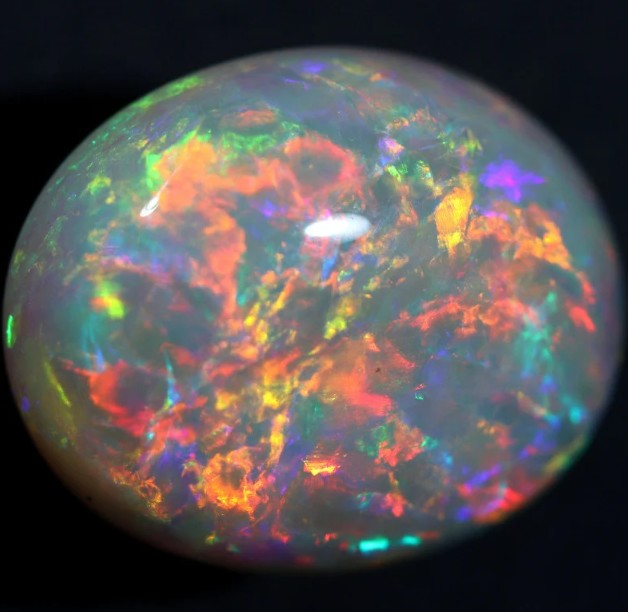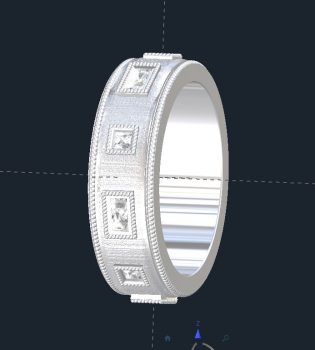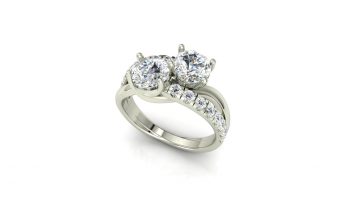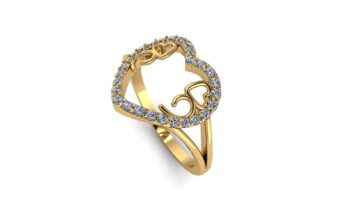Opal Jewelry is the prefect gift for a jewelry lover born in October. A good opal specimen is stunning. Period. They are one of our favorite stones and only have 1 issue with them. They aren’t very durable. However, we will go into this and how to keep your opals looking fresh and crack free. But beyond that, there are few stones in the world as beautiful as opals. We even prefer them to a ruby, sapphire or emerald! There is something to be said for the play of color and movement opals show. The only stone in the same category would be ammolite. However, they are unfortunately even less durable than opals. But that is another post! In this one, we will discuss all things opal.
What Is An Opal?
Opal is a gemstone known for its mesmerizing play of colors. It is composed of hydrated silica and is formed through a process called solidification. Opals can be found in various colors, ranging from white and gray to blue, green, and even black. The play of colors in opals is caused by the diffraction and interference of light as it passes through the tiny silica spheres that make up the stone. This unique optical phenomenon gives opals their distinctive shimmering effect.
Opals have been highly valued throughout history for their beauty and rarity. They have been used in jewelry and decorative objects for centuries. Opals are believed to have metaphysical properties, such as promoting creativity, inspiration, and emotional healing. They are also associated with love and passion.
When choosing an opal, it is important to consider factors such as color, clarity, and play of colors. The most valuable opals are those with a vibrant play of colors that can be seen from different angles. Opals are relatively soft gemstones, so they require special care to prevent scratching or cracking. It is recommended to store opals in a soft cloth or pouch and avoid exposing them to harsh chemicals or extreme temperatures.
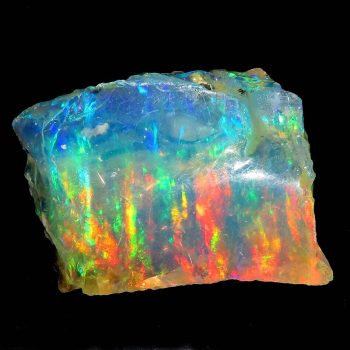
History Of Opal & Opal Jewelry
Opal, a mesmerizing gemstone known for its iridescent play of colors, has a rich and fascinating history. The origins of opal can be traced back to ancient times, with evidence of its use in jewelry dating back thousands of years. The name “opal” is derived from the Latin word “opalus,” meaning “precious stone.” Throughout history, opal has been revered for its mystical properties and captivating beauty.
The history of opal jewelry is intertwined with various cultures and civilizations. In ancient Rome, opal was considered a symbol of hope and purity. It was believed to bring good fortune and protect against evil. Opal jewelry was highly prized and worn by the elite. Similarly, in ancient Greece, opal was associated with love and passion. It was believed to possess the power to enhance emotional well-being and strengthen relationships.
During the Middle Ages, opal fell out of favor due to superstitions surrounding its supposed bad luck. However, in the 19th century, opal experienced a resurgence in popularity. Queen Victoria of England, a trendsetter of her time, was particularly fond of opal jewelry. This royal endorsement sparked a renewed interest in opal, and it quickly became a sought-after gemstone.
Today, opal jewelry continues to captivate people around the world. From delicate opal rings to stunning opal pendants, there is a wide range of designs to suit every taste. Opal is also the birthstone for October, making it a popular choice for birthday gifts. Whether you’re drawn to its mystical allure or simply admire its vibrant colors, opal jewelry is a timeless and enchanting choice.
Opal Range of Colors
The Opal Range of Colors offers a stunning variety of hues. From vibrant blues and greens to fiery reds and oranges, Opals are known for their unique play of color. These gemstones are formed from silica gel, which fills the cracks and voids in sedimentary rocks. As light passes through the Opal, it diffracts and creates a mesmerizing display of colors. Opals are treasured for their beauty and are often used in jewelry, making them a popular choice for those seeking a touch of elegance. Whether you prefer a subtle pastel shade or a bold, vibrant color, the Opal Range of Colors has something to suit every taste.
In addition to their stunning colors, Opals also come in a variety of patterns. The most well-known pattern is the “play-of-color,” which refers to the way the colors dance and change as the stone is moved. This captivating effect is caused by the arrangement of silica spheres within the Opal. Other patterns, such as harlequin, pinfire, and rolling flash, add further intrigue to these already mesmerizing gemstones. With so many different patterns to choose from, Opals offer endless possibilities for creating unique and eye-catching jewelry pieces.
When selecting an Opal, it’s important to consider the color and pattern that best suits your personal style. Some people prefer the classic white Opal with its flashes of color, while others are drawn to the bold and vibrant black Opal. No matter your preference, the Opal Range of Colors offers a wide array of options to choose from. Whether you’re looking for a statement piece or a delicate accent, Opals are sure to add a touch of elegance and beauty to any jewelry collection.
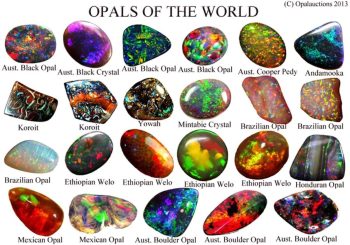
Opal Physical Properties
Opal is a unique gemstone known for its mesmerizing play of colors. It is composed of hydrated silica and belongs to the mineraloid group. Opal is formed through a process called solidification, where silica-rich solutions fill cracks and voids in rocks. This gemstone has a hardness of 5.5 to 6.5 on the Mohs scale, making it relatively soft compared to other gemstones. Opal is also known for its amorphous structure, which gives it its distinctive appearance.
One of the most fascinating physical properties of opal is its play of colors, also known as opalescence. This optical phenomenon occurs due to the diffraction and interference of light waves as they pass through the tiny silica spheres that make up the gemstone. The result is a stunning display of vibrant colors that seem to dance and change as the stone is moved. Opal can exhibit a wide range of colors, including blues, greens, reds, and yellows, making it a highly sought-after gemstone for jewelry.
In addition to its play of colors, opal also has a unique property called opalescence. This is the ability of the gemstone to change its appearance when viewed from different angles. When light enters the opal, it is scattered and reflected back at different angles, creating a captivating iridescent effect. This property adds to the allure and mystique of opal, making it a favorite among gemstone enthusiasts.
Natural vs Lab Grown Opal
Natural opals are highly sought after for their unique patterns and colors. They are formed over millions of years, resulting in a wide variety of opal types, such as black opal, white opal, and fire opal. Each natural opal is one-of-a-kind, making them truly special and valuable.
On the other hand, lab grown opals offer a more affordable alternative. They are created by replicating the natural conditions under which opals form, using a combination of silica and water. While lab grown opals may lack the individuality of natural opals, they still possess the mesmerizing play of colors that make opals so captivating.
Unfortunately, it can sometimes be difficult to tell whether an opal is lab-created or natural. Here are a few tips to help you distinguish between the two.
First, look at the color play of the opal. Natural opals often exhibit a more vibrant and dynamic play of colors, with flashes of red, orange, green, and blue. Lab-created opals, on the other hand, may have a more uniform and predictable color pattern.
Next, examine the pattern of the opal. Natural opals tend to have a unique and irregular pattern, with swirls, dots, or patches of color. Lab-created opals, on the other hand, may have a more symmetrical and uniform pattern.
Finally, consider the price. Natural opals are generally more expensive than lab-created ones. If the price seems too good to be true, it’s likely that you’re looking at a lab-created opal.
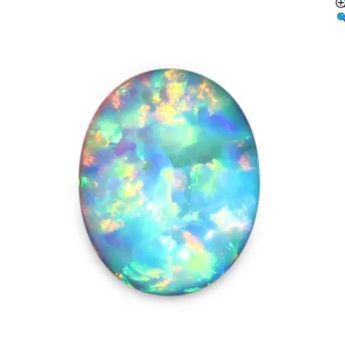
Beliefs About Opal
Opal is a gemstone that has long been associated with various beliefs and superstitions. Many people believe that opals bring good luck and are a symbol of hope and purity. They are thought to enhance creativity and stimulate the imagination. Opals are also believed to have healing properties, particularly in relation to eye and skin conditions. However, it is important to note that these beliefs are based on folklore and personal experiences, and there is no scientific evidence to support them. Nonetheless, opals continue to be cherished and admired for their unique beauty and captivating play of colors.
Why Opal Jewelry Is In Fashion
Opal jewelry has become increasingly popular in the fashion world. The unique beauty and versatility of opals make them a sought-after choice for jewelry enthusiasts. With their captivating play of colors, opals add a touch of elegance and sophistication to any outfit. Whether it’s a delicate opal pendant or a statement opal ring, this gemstone is sure to make a fashion statement.
One of the reasons why opal jewelry is in fashion is its wide range of colors. Opals come in various hues, from vibrant blues and greens to fiery reds and oranges. This versatility allows for endless possibilities when it comes to creating stunning jewelry pieces. Whether you prefer a monochromatic look or a bold, contrasting combination, opals can be incorporated into any design to suit your personal style.
Another factor that contributes to the popularity of opal jewelry is its unique play of colors, known as “opalescence.” This phenomenon occurs when light interacts with the microscopic silica spheres within the gemstone, creating a mesmerizing display of colors. Opals can exhibit a range of colors, including flashes of red, green, blue, and purple. This captivating play of colors adds depth and intrigue to opal jewelry, making it a captivating choice for fashion-forward individuals.
In addition to its aesthetic appeal, opal jewelry also holds symbolic meaning. Opals are believed to bring good luck and happiness to the wearer. They are also associated with creativity and inspiration, making them a perfect choice for artists and those seeking to express their individuality. Whether you wear opal jewelry for its beauty or its symbolic significance, it is clear that opals have become a fashionable choice in the jewelry world.
Notable Opals From the Past & Present
Opals have long been admired for their unique beauty and captivating play of colors. Throughout history, several notable opals have emerged, each with its own fascinating story. One such opal is the Andamooka Opal, discovered in South Australia in 1956. This opal, weighing an impressive 6,843 carats, is known for its vibrant green and blue hues. Another remarkable opal is the Olympic Australis, found in 1956 in Coober Pedy, Australia. This opal, weighing 17,000 carats, showcases a stunning range of colors, including red, blue, green, and yellow. These opals, along with many others, continue to captivate and inspire with their natural beauty and allure.
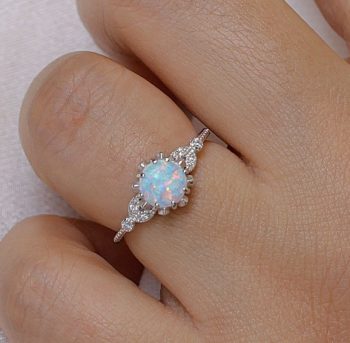
How To Care For Opal Jewelry
Opal jewelry requires special care to maintain its beauty and durability. To keep your opal jewelry looking its best, follow these simple care tips.
First, always store your opal jewelry in a soft cloth or padded jewelry box to prevent scratches. Opals are delicate gemstones and can easily be damaged by other jewelry or hard surfaces. Avoid storing opals in direct sunlight or extreme temperature changes, as this can cause them to crack or fade.
Second, clean your opal jewelry regularly to remove dirt and oils that can dull its shine. Use a mild soap and warm water solution, and gently scrub the jewelry with a soft brush. Rinse thoroughly and pat dry with a clean cloth. Avoid using harsh chemicals or ultrasonic cleaners, as these can damage the opal.
Finally, wear your opal jewelry with care. Avoid exposing it to harsh chemicals, such as household cleaners or perfumes, as these can cause discoloration or damage. Remove your opal jewelry before engaging in activities that may expose it to impact or abrasion, such as sports or gardening.
By following these simple care tips, you can ensure that your opal jewelry remains beautiful and lustrous for years to come. Remember to store it properly, clean it regularly, and wear it with care.
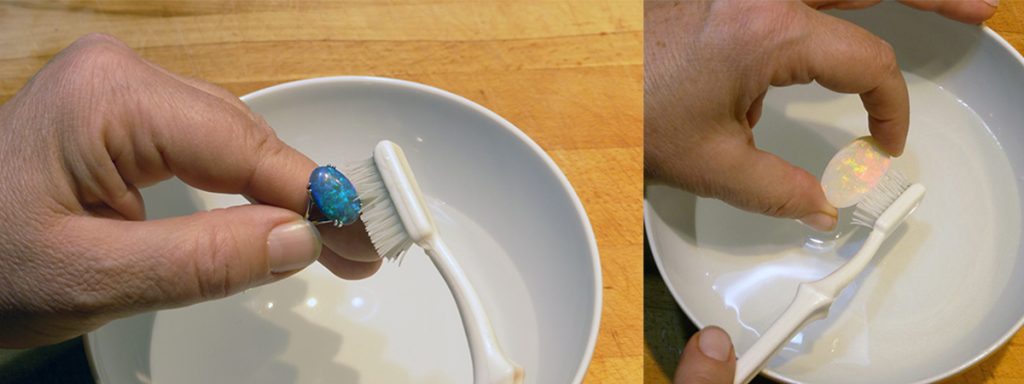
What Does Opal Cost?
Opal prices vary depending on various factors such as quality, size, and origin. The cost of opals can range from as low as $20 per carat to as high as several thousand dollars a carat. The most affordable opals are usually small in size and have lower quality, while larger and higher quality opals can be quite expensive. Additionally, opals from certain regions, such as Australia, are generally more valuable due to their unique color play and rarity. It is important to consider these factors when determining the cost of opals.
On the other hand, lab opals are much more affordable. You can find them for as low as $5 a carat. And the good thing about lab opals is that the price is more linear as stones get larger. Natural stones get exponentially more expensive as they get larger.
Let Us Create Your Opal Jewelry
At Valeria Custom Jewelry, our name says what we do. And that is pretty much all we do. This means that we source each stone for each piece we create. So, you will get to choose the opal you want from all that are available at that point in time. At a retail chain jewelry store, you will be limited to the few stones they have on hand. And do we even need to mention the mark up at those places?
You can view our portfolio of custom engagement rings or custom pendants to look for ideas. Or you can contact us with your own idea.about Opal jewelry.
